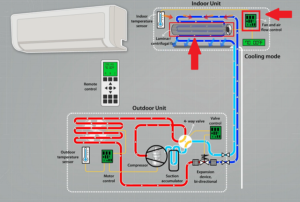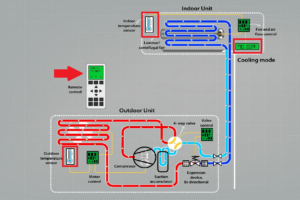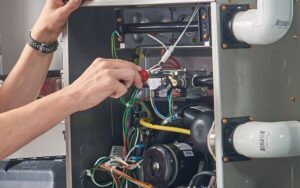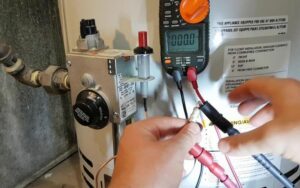There are several reasons why indoor air conditioners, such as mini split air conditioners, are all-time favourites. It works by circulating refrigerant between an outdoor and indoor unit, absorbing heat from the air inside a room and dissipating it outside. This article explores how a mini-split system works and the components it contains.
Table of Contents
ToggleAlso check: Do I Need a Special Thermostat for A Heat Pump?
Elements of a Mini Split System
Mini split systems comprise two main parts: outdoor and indoor units. The evaporator and compressor are located inside and outside the unit. The refrigerant, power, and drain lines connect these two components through a conduit. In the indoor unit, the air is blown into the room by a fan mounted on the wall or ceiling.
How a Mini Split System Works?
The mini split system is designed to be energy-efficient, with most models using inverter technology to adjust the compressor’s speed to match the cooling or heating demand in the room. This means that the compressor doesn’t have to run at full speed all the time, which can help reduce energy consumption and save you money on your energy bills.

Let’s learn about the working mechanism of a mini-split system.
Step 1: The outdoor unit
The outdoor unit of a mini split is installed outside the home or building and contains the compressor, the fan, and the condenser. When the mini split system is turned on, the compressor in the outdoor unit pumps refrigerant through the refrigerant line to the indoor unit. The refrigerant absorbs heat from the indoor unit during the evaporator coil cycle. The fan blows air over the condenser to remove the heat absorbed from the indoor unit.

The condenser is a series of coils that the refrigerant flows through, transferring the heat to the outside air. Upon return to the room, the fan blows cooled air back into it.
Step 2: The indoor unit
The indoor unit of a mini split is mounted on the wall inside the home or building and contains the evaporator, the fan, and the air filter.

Warm air from the room is drawn into the evaporator and passed over the coils, where the refrigerant absorbs the heat. The refrigerant is pumped back to the outdoor unit to release the heat, allowing the cool air to be blown back into the room.
Step 3: The refrigerant
The refrigerant is a chemical compound that transfers heat between indoor and outdoor units. Refrigerant absorbs heat from the warm indoor air and evaporates into a gas, which flows to the compressor in the outdoor unit.

The compressed refrigerant then releases the absorbed heat through the condenser, which cools it into a liquid. A liquid refrigerant pump is then used to repeat this cycle.

Step 4: Filtering the air
A filter helps remove dust and other particles from the air before it is blown back into the room, an essential function of the indoor unit. Your indoor air quality will be improved, and allergens will be reduced.
Step 5: The control system
The control system of a mini split allows the user to adjust the temperature and other settings to meet their comfort needs. Some mini splits come with remote control, while others can be controlled through a mobile app or a smart thermostat.
The control system also allows the user to switch between heating and cooling modes and adjust the fan speed and other settings.

Pros and Cons of Mini-Split Systems
Pros:
The benefits of mini-split systems over central air conditioners are numerous. A few advantages are listed below:
An efficient energy system:
You can save money on your energy bills with mini-split systems because they are highly efficient. Utilizing inverter technology, they adjust the compressor’s speed to match the room’s cooling or heating demand, thereby reducing energy consumption.
Flexible Installation:
Mini split systems don’t require ductwork, so they can be installed in any room or area of your home. Several units can also be installed so that different rooms or areas can be controlled independently.
Operating quietly:
A mini-split system produces an average sound level of 19 dB, which is relatively quiet.
Consequently, they are ideal for bedrooms and home offices.
Enhanced indoor air quality:
Multi-stage filtration systems in mini-split systems can reduce allergy symptoms and improve indoor air quality by removing dust, pollen, and other allergens.
Easy Maintenance:
Mini-split systems are easy to maintain, with most models requiring only a yearly cleaning of the air filter and condenser coil.
Cons:
Upfront cost:
Mini-splits can have a higher upfront cost than traditional HVAC systems, requiring separate indoor and outdoor units and professional installation.
Maintenance:
While mini splits require less maintenance than traditional HVAC systems, they still require periodic cleaning and inspections by a professional technician.
Aesthetics:
The indoor unit of a mini split is mounted on the wall, which some people may find unsightly.
Noise:
Mini-splits can be noisier than traditional HVAC systems, as the indoor unit has a fan that blows air over the evaporator coils.
Also check: What is a Mini Split? | Options, Cost and Applications
Conclusion
Mini split air conditioning systems are cost-effective and energy-efficient to cool or heat your home. They work by circulating refrigerant between an outdoor and indoor unit, absorbing heat from the air inside a room and dissipating it outside. In addition to being energy-efficient, mini-split systems are easy to install, quiet in operation, and offer improved indoor air quality. If you’re considering a new air conditioning system for your home, a mini-split system may be the right choice.
FAQs
How long does a mini-split system last?
The lifespan of a mini-split system is typically between 12-15 years with proper maintenance.
Are mini-split systems able to cool and heat?
The multipurpose nature of mini splits makes them versatile as they can heat and cool.
Can mini-split systems be installed easily?
Mini split systems do not require ductwork, which makes them easier to install than traditional HVAC systems. However, professional installation is still recommended.
Do mini-split systems require maintenance?
Yes, mini-split systems require regular maintenance, including cleaning the air filters and outdoor unit and periodic inspections by a professional technician.





















